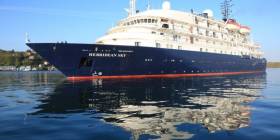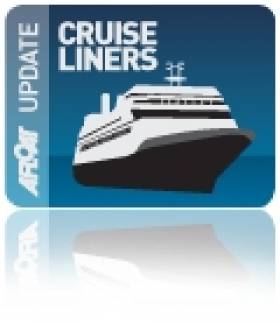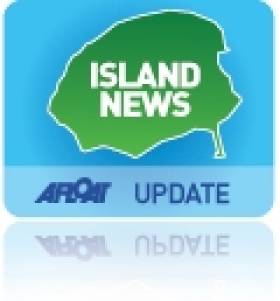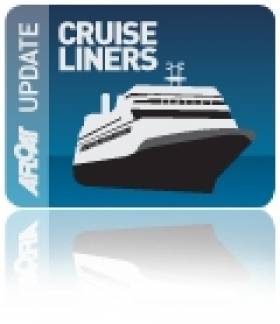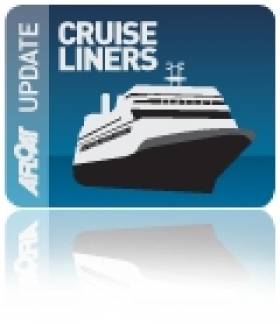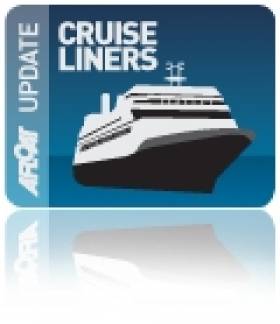Displaying items by tag: Noble Caledonia
#CruiseWaterford - Noble Caledonia, an operator in the high-end small ship cruise market whose latest addition, Hebridean Sky yesterday called to Dun Laoghaire Harbour, having sailed from the quays of Waterford City, writes Jehan Ashmore.
This was the 4,200 tonnes ship’s second call this year to the River Suir quayside berth that allowed her guests easy access to Ireland’s oldest city. The 72 crew of Hebridean Sky with other cruise-goers are to visit the city with a third and final call this season at the end of August.
In all 16 callers are to visit the Port of Waterford, where the smallest cruiseships sail to the city quays whereas Belview, the main terminal for the Port of Waterford caters for medium sized cruiseships. This leaves, Dunmore East at the mouth of the estuary with deeper waters for much larger cruiseships to anchor and passengers tendered and from the fishing harbour.
The former Sea Explorer renamed Hebridean Sky was re-launched for Noble Caledonia this season as one of a trio of flagships, after undergoing a multi-million refurbishment in Sweden. During Spring’s dry-docking of Hebridean Sky, this involved upgrading to both technical and interiors including crew quarters.
At only 90m long the 114 guest cruiseship joins a pair of flagship sisters, Hebridean Sky and Caledonian Sky, the trio are more akin to private yachts and amongst the most luxurious in this market. The trio under Noble Caledonia operate expedition cruising destinations including the Antarctic as well to runnning a fleet of river cruising vessels.
The Caledonian Sky under a previous operator, Hebridean Island Cruises visited Dun Laoghaire Harbour in 2001 as Hebridean Spirit which berthed at the East Pier. On that occasion, I was able to board as a port visitor during a promotional cruise tour. Sadly, the use of this berth, no. 1 is no longer available to visiting tallships, navies and mostly vessels of the Irish Naval Service.
It was noted then the recent changes made to the 'Spirit's exterior styling, notably the single funnel, compared to her sisters twin uptakes. This work was carried out for Hebridean Island Cruises, which still operates Hebridean Princess, which is claimed to be the most luxurious small-cruise ship in the world.
The former CalMac ferry, Columba, mostly cruises throughout the Scottish Isles, but also the rest of the UK and occasional calls to Ireland.
Overnight 'Island Sky' Cruise to Dun Laoghaire Harbour to Mark Dawn of Third Cruise Season
#CruiseDunLaoghaire – Dun Laoghaire Harbour's third cruise season will begin with Island Sky, the 118 passenger vessel is sailing overnight from Waterford under command of Swedish master, Captain Karlsson, and is due in the morning, writes Jehan Ashmore.
On this Noble Caledonia operated cruise there are 87 passengers on board and she is one of four callers for the 2014 season, which is considerably less than the scheduled 14 callers last year.
Having said that Dun Laoghaire Harbour Company can look forward in welcoming the return of impressive five-masted cruiseship, Wind Surf, which twice called in 2013 and in which cruise passengers embarked at the port having flown in from the US.
The Windstar Cruise vessel as previously reported on Afloat.ie is likewise of Island Sky visiting Waterford Estuary this year, though today she headed upriver to the city quays, while the wind-assisted vessel is to anchor this summer off Dunmore East.
As for Island Sky's arrival tomorrow morning, she is to pick up a pilot from a Dublin Port cutter prior to entering Dun Laoghaire Harbour where she is to berth alongside Carlisle Pier.
She is a sister of Sea Explorer which notably arrived without passengers nor embarked, as the former Renaissance Cruises vessel went into lay-up in March 2013, prior to resuming a new career cruising in northern Europe.
The old mailboat and former conventional car-ferry terminal pier is where the immacutely painted Serenissima, a classic former Norwegian 'Hurtigruten' Harald Jarl built in 1960 became the first caller to Dun Laoghaire in 2013. She also was the first to actually dock within the harbour and on the same day saw the historic first call of Cunard Line's flagship Queen Mary 2 that anchored offshore.
This season's line-up may not be as extensive, yet Dun Laoghaire Harbour's visit of Island Sky is a first so is Seabourn Cruises luxury mega-yacht style Seabourn Legend.
Under the National Ports Policy launched last year by Minister for Transport, Leo Varadkar, Dun Laoghaire Harbour along with four other ports where classed as having 'regional significance'.
In Dun Laoghaire's case the development of the harbour is to refocus in meeting local requirements that focus on tourism, cruise liners and marine leisure activity.
Waterford Cruise Season to Blossom in May
#Cruiseliners – Waterford Estuary is to welcome more than 20 cruise calls in 2013 with the first caller being Island Sky in early May, writes Jehan Ashmore.
The small 118 passenger cruiseship operated by Noble Caledonia and with a crew of 77 will make a brief anchorage call off Dunmore East.
During the afternoon visit, passengers are to visit the Mount Congreve Gardens, a spectacular woodland garden upriver on the banks of the River Suir.
Among the other callers that month are the 110 passenger Serenissima, a former Norwegian vessel that served on the Hurtigruten coastal service and also as the Andrea running cruises to polar-regions. She is to dock alongside Waterford's city-centre quays.
The third location on the estuary where cruiseships call is Belview, downriver of the city facing Waterford Island. The container terminal facility which is the primary port for Waterford is where the 408 passenger Hamburg is due to berth. For a list of all liners calling this season click HERE.
Busy Day for Aran Islands Capital
#ARAN ISLANDS CRUISE CALL – Two vessels, a cruiseship and a lighthouse tender are today off Kilronan, the capital of Inishmore, the largest of the Aran Islands, writes Jehan Ashmore.
The ships are the 114 passenger cruiseship Island Sky (1992/4,200grt) operated by Noble Caledonia which called this morning having originally departed in Portsmouth and the Commissioners of Irish Lights tender ILV Granuaile (2000/2,365grt) which is based in her homeport of Dun Laoghaire.
Kilronan will be a hive of activity, not just those passengers tendered ashore from the cruiseship but also tourists arriving by frequent ferry services from Rossaveal, Co. Galway and Doolin in Co. Clare. The majority of sightseers will no doubt be heading for the main attraction of Dun Aengus fort on the far side of the island which is reached by shuttle buses and the traditional pony and trap.
The Island Sky's sister the Caledonian Sky which too is operated by the same company made yesterday an anchorage call off Sneem Co. Kerry. It is along the western seaboard that such smallships are attracting a niche market. In addition it is in these same waters is where ILV Granuaile is more often to be found working during the summer months as the weather is more favourable to carry out aids to navigation duties.
Unlike the cruiseship, the lighthouse tender does not actually anchor. Instead she can maintain a constant position using dynamic positioning (DP) which uses satellite technology to adjust the vessels manouvering systems to precise pin-point accuracy.
Small Cruiseship Set Sails for Sneem
#COASTING CRUISING – The small expedition cruiseship Clipper Odyssey (1989/5,218grt) departed Cobh Cruise Terminal this evening on a short cruise-hop along the West Cork coastline to Sneem in neighbouring Co. Kerry, writes Jehan Ashmore.
The twin funnelled vessel is normally associated with cruising in the Pacific on cruises from New Zealand to the Russian Far-East. For 2012, however she will be voyaging also to the Scottish Isles, Faroe Islands and Norway having previously served earlier this year on Indian Ocean safari cruises from Zanzibar to Mozambique visiting Madagascar and Mauritius.
A crew of 70 look after 128 guests accommodated in 64 cabins. Of the staterooms they all have ocean views, and each feature lower level beds, a private bathroom, sitting area with sofa, individual temperature control, in-room music systems and television.
At the stern is the fitness suite and outdoor pool. Other facilities include a lounge, library, gym, a medical clinic staffed by a registered physician and a gift shop. The small vessel is ideally suited for calling to shallower waters, where passenger can reach shore destinations using the vessels own tender fleet made up of Zodiac craft.
The Bahamas flagged vessel was last refurbished this time last year and she is operated by Noble Caledonia which specialise in providing a diverse range of cruising opportunities including those sailing under sail.
The company's Caledonia Sky (1991/4,200grt) has also been cruising in Irish waters this week. The 114 passenger vessel is better known as the Hebridean Spirit which had for many years operated for Hebridean Island Cruises. While on a cruise around a decade ago she made a rare promotional port of call to Dun Laoghaire Harbour.
Historic First as Cruiseship Calls to Drogheda Port
#DROGHEDA CRUISE CALL – The first ever cruiseship to visit Drogheda Port was welcomed this morning as Noble Caledonia' 122 passenger Clipper Adventurer (1975/ 4,367grt) entered the mouth of the Boyne, writes Jehan Ashmore.
Onlookers came out to view the historic arrival of the 101m long vessel which normally cruises in polar waters, either Antarctica or the Arctic. She berthed at Tom Roe Terminal, downriver from the older town-centre quays, having set off from Cork earlier this month on a 10-day circumnavigation cruise of Ireland.
On board the ice-strengthened exhibition vessel were American and Canadian passengers who were on the cruise organised by Adventure Canada, in association with Royal Canadian Geographical Society. Prices for the cruise which featured a varied lecture programme started from $3,995 dollars.
Facilities include a main lounge, bar, clipper club, library/card room, gymnasium and gift shop and throughout the intimate vessel, she sports plenty of varnished wood, brass, and timber lined decks. The new outside cabins have lower beds and private facilities in addition each with window view.
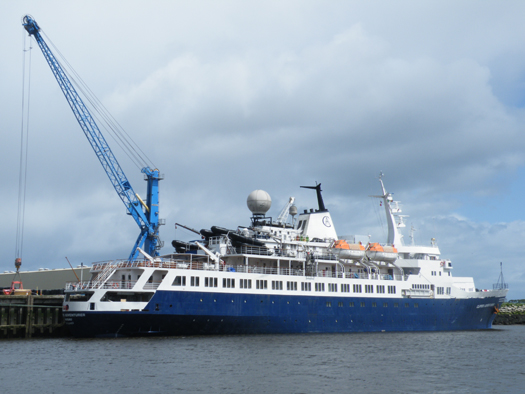
M.V. Clipper Adventurer moored alongside Tom Roes Terminal, Drogheda Port.
Photo: Jehan Ashmore
It is estimated the passenger spend generated from the cruise to the Boyne Valley is €60,000, the windfall will be a boost to the local economy. On foot of this the Drogheda Port Company has been in dialogue with a number of interested parties to build the brand and grow cruise business tourism in the region.
A small cruiseship such as Clipper Adventurer offers a more 'boutique' style of operation, in that she calls to more isolated destinations compared to the really large cruiseships. Among the ports of call on this Irish cruise they were to Kinsale, Dingle, Cliffs of Moher, Aran Islands, Westport and Tory Island.
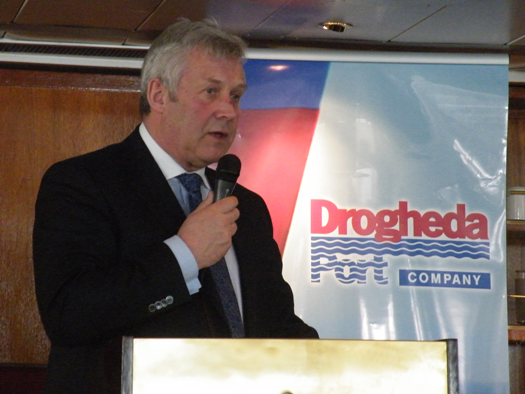
Minister of State Fergus O'Dowd speaking at a reception on board Clipper Adventurer to mark the historic cruise call visit
Where there are no port berthing facilities, passengers use instead a fleet of the vessels zodiacs which whisk them ashore to make excursions. Today her passengers disembarked to take a coach tour to the world famous visitor attractions along the Boyne Valley, before flying out of Dublin airport.
Not only is the cruise call a first for Drogheda Port but where a fly-cruise option is made available and also in reverse as the crew of the Clipper Adventurer are to welcome this evening more passengers flying in from Denmark. These passengers are to embark on a 6-day cruise of the Scottish Isles, terminating at Lerwick. The cruise is organised by Copenhagen based Albratros Tours.
Cruiseship's Return Consolidates New Business
#CRUISE CALLER – The small expedition cruiseship Quest made a return port of call to Dun Laoghaire Harbour early this morning, having inaugurated the season last month, writes Jehan Ashmore.
The 50m long vessel operated by Noble Caledonia carries 52 passengers and a crew of 25 had sailed overnight from Holyhead. She departed the Anglesey port at 20.00hrs and she took a leisurely 10-hour passage to cross the 60 nautical mile Irish Sea route.
Her visit to Dun Laoghaire today will provide her passengers to visit Powerscourt and Mount Usher Gardens in Co. Wicklow as part of a Garden themed cruise throughout destinations in the UK and Ireland.
On this occasion she is taking the cruise in reverse direction having previously made a southbound circuit starting at Oban and ending in Poole.
Likewise to her call nearly three weeks ago, she is moored alongside Carlisle Pier, which is designated berth number two out of a total five berths that are used for commercial vessels.
Circumnavigation Cruise of Ireland Deferred as Bad Weather Delays Cruiseship from Argentina
#CRUISE LINERS – Due to bad weather a 11-day circumnavigation cruise of Ireland by Clipper Adventurer which is currently en-route from Argentina has been diverted to Cork, deferring the start of the cruise which was due to depart from Waterford today, writes Jehan Ashmore.
The 101m long vessel operated by Noble Caledonia was to welcome over 230 American and Canadian passenger on a cruise organised by Adventure Canada, in association with Royal Canadian Geographical Society.
According to the cruise itinerary the tourists were firstly to fly to Dublin and stay last night in a city-centre hotel. Also originally as scheduled was a coach tour today to visit Glendalough and the Rock of Cashel before reaching Waterford this afternoon to board the small expedition ship.
Despite the setback the 4,000 tonnes vessel with a crew of 65 which is on a repositioning voyage from South America to Europe was to make Cork her port of call tomorrow anyway. The only change being the embarkation port at the expense of the crystal city.
Clipper Adventurer is expected to arrive in Cork Harbour from 12 noon tomorrow and head for Ringaskiddy Deepwater Terminal. Also due is the 290m Emerald of the Seas which at 113,000 tonnes is in complete contrast as the massive vessel can accommodate over 3,500 passengers and 1,200 crew. She is to berth at Cobh cruise terminal.
Asides cruise callers the ferryport in Ringaskiddy will be as usual expecting the weekend-only call of Brittany Ferries flagship cruiseferry Pont-Aven, having made a crossing overnight from Roscoff.
While on the May Bank Holiday Monday Cobh is also set to welcome an even larger cruise caller in the form of the Independence of the Seas. The 154,000 tonnes giant is no stranger to the harbour as she made her maiden 'Irish' port of call in 2007. She can handle over 4,300 passengers and over 1,300 crew alone.
Cruise Call Opens New Opportunities for Dun Laoghaire Harbour
#CRUISE CALLS - The docking of the Quest in Dun Laoghaire Harbour this morning marks the first phase of cruise calls this summer as part of a new development to attract cruiseships, writes Jehan Ashmore.
The opening of the cruise sector business which formed part of the Dun Laoghaire Harbour Company's Masterplan is seen as a significant boost to the local economy considering the declining operations of the HSS fast-ferry service in recent years.
The Quest which is operated by Noble Caledonia is on a 9-night 'Garden' Cruise of the UK and Ireland, where prices started from £3,295. She berthed at the Carlisle Pier where for many generations passengers boarded the mail-boats followed by the conventional ferry to Holyhead which last left the route in 1996.
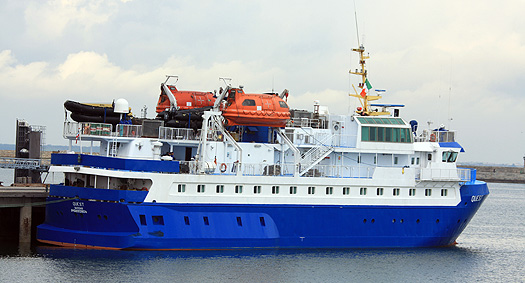
Quest along side in Dun Laoghaire. She carries 50 passengers
At just under 50m long the Quest carries only 50 passengers though this number is set to increase when a further four cruise calls are scheduled this season with larger vessels capable of carrying around 500 passengers.
#CRUISELINERS – The Quest (1992/1,180grt) an ice-strengthened expedition cruiseship, will have the distinction of being the first cruise caller to Dun Laoghaire Harbour in many years. The cruise call next week (24th April) will mark a new era in attracting the cruise sector as part of the harbour's masterplan launched last year, writes Jehan Ashmore.
The Quest will have a German clientele of around 50 passengers, though other larger capacity vessels are scheduled for the summer in this first phase of cruise callers. The cruise sector season is seen to be a significant economic boost to the local economy considering the reduced ferry side of the harbour business in recent years.
Passengers on the Noble Caledonia operated vessel are to take a 9-night 'Garden' Cruise with prices starting from £3,295. She is to set sail from Oban Scotland, then to Ireland, Wales, Cornwall, the Isles of Scilly and Channel Islands.
On her Dun Laoghaire call passengers will head for Powerscourt and nearby Mount Usher gardens in Co. Wicklow. On the second Irish port of call to Waterford as previously reported, they will visit the privately owned Mount Congreve Gardens on the banks of the River Suir.
Notably scheduled in for next year's season is the 'flagship' of the Cunard Line fleet, the 2,620 passenger liner Queen Mary 2, all of 151,400 gross tonnes. She is to make an anchorage call in May 2013, according to Captain Frank Allan, Dun Laoghaire Harbourmaster.
As part of the programme to attract and develop Dun Laoghaire as a cruise call port of call, a new tender docking facility was recently completed. The facility is designed to cater for large cruiseships using the harbour as it will cater for easier access by boats tendering passengers to vessels such as Queen Mary 2 during anchorage calls out in Dublin Bay.
The new tender facility will also benefit the public as the facility can be used for training purposes and for the operation of boat tours around Dublin Bay and trips out to Dalkey Island.
- Dun Laoghaire Harbour
- Cruise Liners
- Irish cruise calls
- Noble Caledonia
- MVQuest
- Cunard Line
- Queen Mary 2
- QM2
- Dun Laoghaire Harbour Company
- Dublin Bay
- Dublin Bay anchorage cruise calls
- Dalkey Island
- Powerscourt Gardens
- Mount Congreve Gardens Waterford
- River Suir
- Dun Laoghaire Harbour Masterplan
- Dublin Bay News


























